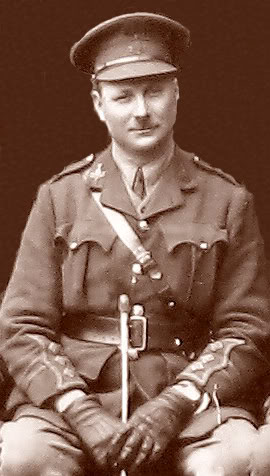
Submitted by Pat Burgess.
The Graham family were local to Barnard Castle, they lived on The Bank, where father John had a chemist and grocery business. John Austin was born on 2 March 1872.
After his time at school from 1886 until 1889, he took a Electrical Engineering apprenticeship. Later he started an electrical business with his brother – Graham Brothers Electrical Engineers in Middlesbrough.
He was secretary of the Saltburn R.N.L.I. and a gifted operatic singer.
Serving as a territorial captain, Austin Graham was with the 4th battalion when war broke out in August of 1914. He landed with the battalion at Boulogne on April 18th
1915 when the battalion was almost straight away thrown into the 2nd battle of Ypres. On April 24th Captain Graham and his men had their first taste of action in fierce fighting during the Battle of St Julien. On Whit Monday 1915 the battalion were in trenches astride the Menin Road at Hooge and Austin Graham was badly gassed and hospitalised with his injuries. In early 1918 the battalion were back in the Ypres sector and when the German Spring Offensive opened on March 21st they were in a position close to Hancourt. There followed nine days of fighting on the retreat under the enemy onslaught. A brief rest at Bethune followed this and then on April 8th the battalion was moved up to take part in the Battle of the Lys.
By now CO of the 4th battalion Major Austin Graham was wounded in action during efforts to hold a bridge at Sailly sur La Lys. He died of his wounds the following day April 11th 1918.
He is buried in Haverskerque British Cemetery.
Explore more memories from the ribbon
-
John Smith
Jane Metcalfe visited the museum and outlined the story of her father, John Smith. He was born in Dundee, Forfar in 1883. After working as a boilermaker, he joined the Royal Engineers on 1 September 1909 and remained in military service until 31 January 1930. He spent time at Catterick Camp one hundred years ago at the time of the garrison’s founding. During the First World War John served in Egypt, before being transferred to the British Expeditionary Force in France. He became a Lance Corporal, and was promoted to Sergeant in April 1917. His record was ‘Exemplary’, and he was described as ‘Extremely honest, sober and reliable. A good organiser and very good in charge of men.’ 1852361 Sergeant John smith was awarded the 1914 Star, the British War medal, the Victory medal, the General Service medal and the Long Service and Good Conduct medal.
-
Captain Leonard Yorke MC
Born in Church Fenton, Yorkshire in 1889, Leonard Yorke’s life was to come to a tragic conclusion ten years after the First World War came to an end. In his early years, Leonard lived in Castleford, the son of a Station Master with the NER. He moved to London to become an Electrical Engineer and following the outbreak of war was gazetted as a 2nd Lieutenant in the 4th Battalion, Yorkshire Regiment. By May he was in Belgium where on 24th and 25th the 4th Battalion were involved in heavy fighting. 2nd Lt Yorke was pulled out of the line due to being a vicitm of the first gas attack of the war, not returning to front line duties until August 1915. In late 1916 he was promoted to Lieutenant and by June 1917 he had attained the rank of Captain. His Military Cross citation of 28th September 1918 states that he “displayed great courage in the leading of his platoon at a time of exceptional difficulty and danger…..He was seriously wounded during the action”. The Yorkshire Post of 11 October 1918 reported “Capt. Leonard James Yorke, Yorkshire Regiment, son of Mr James Yorke, 19 South End Avenue, Darlington, has been wounded and is in hospital abroad”. After two years in hospital, Yorke was invalided out of the army. Leonard Yorke returned to London after leaving the army, but couldn’t cope following the stresses of war. On May 2nd 1929, Yorke shot himself on Hampstead Heath. At the inquest his…
-
Harry Kinchin
Harry was born sometime in the 2nd quarter of 1880 in Richmond North Yorkshire. He was the son of John James and Martha Kinchin of 11 Castle Hill Richmond. His father worked as a joiner. Harry was the eldest of eight children. The 1901 census shows Harry, 20, Walter 18, Allanson 16, Annie, 14, Moses 11, Martha 8, Elizabeth 5 and James Stroud 1. By the 1911 census Harry was married to Priscilla and had two daughters, Lilla 7 and Muriel Martha 1, and a son Walter 4. Harry also made a living as a joiner. At the time they resided at 7 Reynoldson Yard in Richmond. At the outbreak of war Harry and his brother Allanson joined up and went into the 4th Battalion Yorkshire Regiment. Harry and Allanson left with the 4th Battalion from Newcastle for France on the 17th April 1915 and after disembarking at Boulogne on the 18th arrived at Ypres by the 23rd. The Battalion was immediately involved in the 2nd Battle of Ypres and on the 24th April were ordered to make an attack on St Julien. During the attack 5 officers and 10 other ranks were killed. On the next day, the 25th, the Battalion had just the one man killed in the trenches. Harry’s death is recorded as the 25th so he could have been that single death, or it’s possible that he was actually killed the day before. He was 34 years of age. Harry may have been buried after his…
